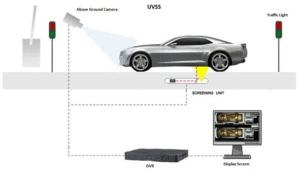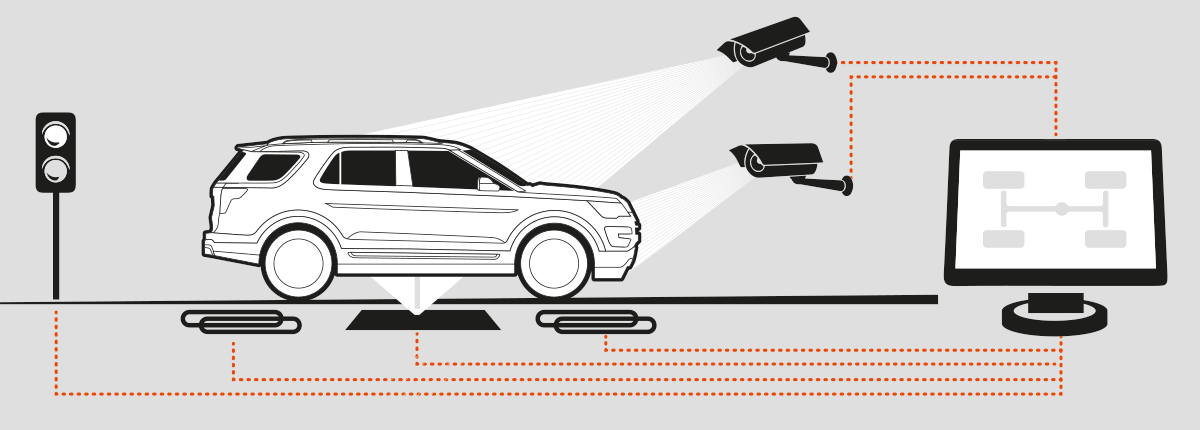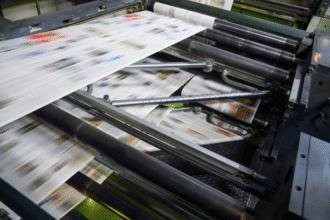In today’s heightened security landscape, deploying an under vehicle surveillance system is no longer optional—it is essential. At the same time, an under vehicle inspection system provides an equally vital layer of protection for facilities, borders, and critical infrastructures. This comprehensive guide will explain how UVSS and UVIS solutions work, why they matter, and how organizations can implement them effectively.
What is an Under Vehicle Surveillance System (UVSS)?
An under vehicle surveillance system (UVSS) is a technology platform designed to capture high-resolution images or video of a vehicle’s undercarriage as it drives over a scanning unit. Unlike traditional manual inspection using mirrors, UVSS enables operators to examine the full underside quickly, accurately, and with digital records. The technology is widely used at high-security checkpoints, stadiums, airports, and government facilities.
What is an Under Vehicle Inspection System (UVIS)?
While the terms are often used interchangeably, an under vehicle inspection system (UVIS) emphasizes the broader inspection capability of scanning the vehicle underside for anomalies, hidden contraband, or damage. A UVIS typically includes high-resolution cameras, illumination systems, image-processing software, and alert triggers for items attached beneath a vehicle. In effect, a UVIS is a specialised form of vehicle screening which overlaps with the functionality of a UVSS solution, but can also emphasise asset inspection and maintenance in non-security contexts.
Why These Systems Matter: Key Benefits

Rapid and Non-Intrusive Inspection
With a UVSS or UVIS in place, vehicles can be scanned in motion at entry-points, reducing queue times and avoiding the need for manual checks. This ensures traffic flow remains smooth while maintaining security integrity.
Enhanced Threat Detection and Anomaly Identification
Modern under-carriage scanning platforms integrate AI and high-resolution imaging to detect explosives, hidden compartments, contraband, vehicle damage, or tampering. Manual mirror inspections are slow and prone to human error.
Digital Records and Comparison Capability
Many systems store undercarriage images along with licence plate recognition (LPR) data, enabling history-based comparison, anomaly-tracking, and audit-trails.
Improved Safety for Security Personnel
Rather than placing human inspectors beneath or beside vehicles, UVSS/UVIS units offer remote inspection capability, reducing risk to staff and ensuring safer operations.
Key Features & How They Work
Imaging and Scanning Hardware
Under-vehicle scanning platforms consist of embedded or surface-mounted camera units passed over by vehicles. LED or infrared lighting ensures clear undercarriage visibility even in low-light conditions.
Image Processing and Analytics
Captured images are stitched and corrected to present a full view of the undercarriage. Advanced analytics then detect deviations from reference images, flagging threats or damage.
Integration with Existing Security Systems
Modern UVSS/UVIS toolsets integrate with automatic number plate recognition (ANPR/LPR), access control, barriers, and other modules for layered security.
Deployment Flexibility: Fixed vs Portable
Some systems are permanently embedded in roadways, while others offer portable solutions for temporary checkpoints or events. Portable units allow rapid deployment and repositioning as needed.
Use-Cases and Industry Applications
Critical Infrastructure & Government Sites
Facilities such as power plants, border crossings, and military installations require secure vehicle access screening. UVSS/UVIS systems provide non-intrusive inspection while maintaining high throughput.
Stadiums, Arenas & Events
Large venues hosting tens of thousands of vehicles need efficient and reliable screening. A UVSS deployment allows vehicles to be inspected quickly without disrupting traffic flow.
Logistics, Warehousing & Industrial Facilities
In shipping yards or logistic hubs, under-vehicle inspection can detect hidden contraband, damage to vehicles, or tampering that may affect operations.
Commercial & Residential Complexes
High-rise offices, hotels, and gated communities can enhance their access control by adding UVSS scanning at vehicular entry points, increasing the security perimeter.
How to Choose the Right Under Vehicle Surveillance / Inspection System
Match the Solution to Site Requirements
Consider vehicle types (cars, trucks, trailers), speed of inspection, traffic volume, and environmental conditions (harsh climate, embedded vs portable).
Specify Imaging & Analytics Capability
Ensure the system offers high-resolution imaging, de-warping of images, AI-based anomaly detection, and integration with metadata like licence plates.
Evaluate Deployment and Maintenance Implications
Fixed systems require roadworks; portable systems allow flexibility. Maintenance accessibility, durability, and ease of integration are key.
Integration with Broader Security Ecosystem
An under vehicle surveillance system or inspection system should integrate with access control, barrier systems, CCTV, and security management software for full efficacy.
Best Practices for Implementation
- Site Survey and Traffic Assessment:Analyse vehicle speed, angle, lighting, and traffic flow to determine optimal placement.
- Calibration and Reference Image Capture:Establish baseline undercarriage images for each vehicle class or fleet to enable anomaly comparisons.
- Operational Workflows:Define inspection protocols for flagged vehicles, alerts, recording, and audit.
- Training of Operators:Ensure security personnel are trained on reading displays, handling alerts, and maintaining the system.
- Regular System Audit and Updates:Monitor performance metrics, update analytics algorithms, and ensure hardware remains clean and calibrated.
Future Trends in Under-Vehicle Screening Technology
As threats evolve, so do the capabilities of under-vehicle inspection and surveillance systems. Key trends include:
- 3D stereo-vision scanning and depth-mapping of the undercarriage for deeper anomaly detection.
- AI-driven automatic anomaly detection that reduces operator workload and false-positive rates.
- Seamless integration with smart campus security platforms, IoT sensors, and remote monitoring.
- Enhanced portability and modularity allowing rapid deployment for temporary events or changing threat environments.
Why UVSS.ai Is Your Ideal Partner for Under-Vehicle Security
At uvss.ai, we specialise in delivering tailored under vehicle surveillance system and under vehicle inspection system solutions that meet complex security demands across sectors. Our expertise spans hardware selection, software analytics, seamless integration, and full lifecycle support. Whether you are securing a border crossing, logistics hub, or commercial facility, our solutions ensure you stay ahead of emerging threats and optimise operational efficiency.
Conclusion
Installing an under vehicle surveillance system combined with an effective under vehicle inspection system strategy elevates your security posture by enabling fast, accurate, non-intrusive vehicle screening. From critical infrastructure to event venues, the benefits are clear: higher throughput, fewer human-error gaps, richer data capture, and future-proof analytics. As threats continue to evolve, organisations must adopt these next-generation technologies to ensure safety, continuity, and resilience. Trust uvss.ai to lead your deployment and maximise your security investment.
Get a free sales enquiry or demo today and see how UVSS can help you achieve real results.
Our team will walk you through how our solutions fit your needs – no cost, no obligation.
Reach out now to book your free demo or speak with a specialist.
Contact us on UVSS – we’re ready to help you get started.
✉️ Email: sales@uvss.ai
📞 Call: 00447944834433
💬 WhatsApp: https://wa.me/00447944834433
🌐 Visit: https://uvss.ai
AI UVSS Under Vehicle Surveillance System
#UVSS #UnderVehicleSurveillanceSystem #uvss_system #security #commercialbuilders #checkpoints
















